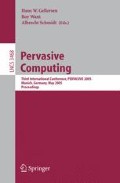Abstract
This paper proposes and evaluates interaction techniques for camera-equipped mobile phones. The proposed techniques are based on a visual code system that provides a number of orientation parameters, such as target pointing, rotation, tilting, distance, and relative movement. Our conceptual framework defines a set of fundamental physical gestures that form a basic vocabulary for describing interaction when using mobile phones capable of reading visual codes. These interaction primitives can be combined to create more complex and expressive interactions. A stateless interaction model allows for specifying interaction sequences, which guide the user with iconic and auditory cues. In using the parameters of the visual code system as a means of input, our framework enhances the currently limited input capabilities of mobile phones. Moreover, it enables users to interact with real-world objects in their current environment. We present an XML-based specification language for this model, a corresponding authoring tool, and a generic interpreter application for Symbian phones.
Access this chapter
Tax calculation will be finalised at checkout
Purchases are for personal use only
Preview
Unable to display preview. Download preview PDF.
References
Want, R., Fishkin, K.P., Gujar, A., Harrison, B.L.: Bridging physical and virtual worlds with electronic tags. In: Proceedings of the SIGCHI conference on Human factors in computing systems, pp. 370–377. ACM Press, New York (1999)
Fishkin, K.P.: A taxonomy for and analysis of tangible interfaces. Personal Ubiquitous Comput. 8, 347–358 (2004)
Fishkin, K.P., Moran, T.P., Harrison, B.L.: Embodied user interfaces: Towards invisible user interfaces. In: Proceedings of the Seventh Working Conference on Engineering for Human-Computer Interaction, pp. 1–18. Kluwer, Dordrecht (1999)
Ballagas, R., Rohs, M., Sheridan, J.G., Borchers, J.: Sweep and Point & Shoot: Phonecam-based interactions for large public displays. In: CHI-2005: Extended abstracts of the 2005 conference on Human factors and computing systems. ACM Press, New York (2005)
Rohs, M.: Real-world interaction with camera-phones. In: 2nd International Symposium on Ubiquitous Computing Systems (UCS 2004), Tokyo, Japan, pp. 39–48 (2004)
Rohs, M., Gfeller, B.: Using camera-equipped mobile phones for interacting with real-world objects. In: Ferscha, A., Hoertner, H., Kotsis, G. (eds.) Advances in Pervasive Computing,Austrian Computer Society (OCG), pp. 265–271 (2004)
Kindberg, T.: Implementing physical hyperlinks using ubiquitous identifier resolution. In: Proceedings of the eleventh international conference on World Wide Web, pp. 191–199. ACM Press, New York (2002)
Fitzmaurice, G.W., Zhai, S., Chignell, M.H.: Virtual reality for palmtop computers. ACM Trans. Inf. Syst. 11, 197–198 (1993)
Fitzmaurice, G., Buxton, W.: The Chameleon: Spatially aware palmtop computers. In: CHI 1994: Conference companion on Human factors in computing systems, pp. 451–452. ACM Press, New York (1994)
Rekimoto, J.: Tilting operations for small screen interfaces. In: Proceedings of the 9th annual ACM symposium on User interface software and technology, pp. 167–168. ACM Press, New York (1996)
Harrison, B.L., Fishkin, K.P., Gujar, A., Mochon, C., Want, R.: Squeeze me, hold me, tilt me! an exploration of manipulative user interfaces. In: Proceedings of the SIGCHI conference on Human factors in computing systems, pp. 17–24 (1998)
Bartlett, J.F.: Rock ’n’ scroll is here to stay. IEEE Comput. Graph. Appl. 20, 40–45 (2000)
Hinckley, K., Pierce, J., Sinclair, M., Horvitz, E.: Sensing techniques for mobile interaction. In: Proceedings of the 13th annual ACM symposium on User interface software and technology, pp. 91–100. ACM Press, New York (2000)
Wigdor, D., Balakrishnan, R.: TiltText: Using tilt for text input to mobile phones. In: Proceedings of the 16th annual ACM symposium on User interface software and technology, pp. 81–90. ACM Press, New York (2003)
Hinckley, K., Sinclair, M., Hanson, E., Szeliski, R., Conway, M.: The VideoMouse: A camera-based multi-degree-of-freedom input device. In: Proceedings of the 12th annual ACM symposium on User interface software and technology, pp. 103–112. ACM Press, New York (1999)
Zhai, S.: User performance in relation to 3D input device design. SIGGRAPH Comput. Graph. 32, 50–54 (1998)
Brewster, S.A.: Using nonspeech sounds to provide navigation cues. ACM Transacti ons on Computer-Human Interaction 5, 224–259 (1998)
Brewster, S., Brown, L.M.: Tactons: Structured tactile messages for non-visual information display. In: Proceedings of the fifth conference on Australasian User Interface, pp. 15–23. Australian Computer Society, Inc. (2004)
Accot, J., Zhai, S.: More than dotting the i’s –foundations for crossing-based interfaces. In: Proceedings of the SIGCHI conference on Human factors in computing systems, pp. 73–80. ACM Press, New York (2002)
Raskin, J.: The humane interface: New directions for designing interactive systems. ACM Press/Addison-Wesley Publishing Co.(2000)
Buxton, W.: A three-state model of graphical input. In: Proceedings of the IFIP TC13 Third Interantional Conference on Human-Computer Interaction, pp. 499–456. North- Holland, Amsterdam (1990)
Tapia, M.A., Kurtenbach, G.: Some design refinements and principles on the appearance and behavior of marking menus. In: Proceedings of the 8th annual ACM symposium on User interface and software technology, pp. 189–195. ACM Press, New York (1995)
Gomoll, K., Nicol, A.: Discussion of guidelines for user observation. From: User Observation: Guidelines for Apple Developers (1990)
Author information
Authors and Affiliations
Editor information
Editors and Affiliations
Rights and permissions
Copyright information
© 2005 Springer-Verlag Berlin Heidelberg
About this paper
Cite this paper
Rohs, M., Zweifel, P. (2005). A Conceptual Framework for Camera Phone-Based Interaction Techniques. In: Gellersen, H.W., Want, R., Schmidt, A. (eds) Pervasive Computing. Pervasive 2005. Lecture Notes in Computer Science, vol 3468. Springer, Berlin, Heidelberg. https://doi.org/10.1007/11428572_11
Download citation
DOI: https://doi.org/10.1007/11428572_11
Publisher Name: Springer, Berlin, Heidelberg
Print ISBN: 978-3-540-26008-0
Online ISBN: 978-3-540-32034-0
eBook Packages: Computer ScienceComputer Science (R0)

